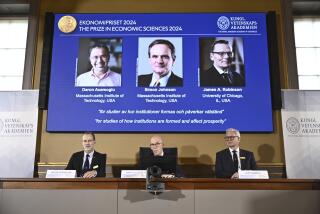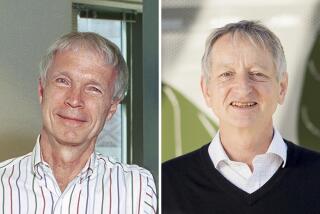2 Americans, German Win Nobel Prizes
- Share via
Two American scientists won the 1985 Nobel Prize in Chemistry on Wednesday for a method they developed to determine the structure of small molecules, a major step in the development of hundreds of modern drugs.
The Nobel Prize in Physics went to a West German physicist, Klaus von Klitzing, who figured out a way to measure electrical resistance exactly, an important benchmark in the electronics industry that could lead to improved consumer products.
Both prizes were announced by the Royal Swedish Academy of Sciences in Stockholm.
The two American winners in chemistry were Herbert Hauptman, 68, executive vice president for research at the Medical Foundation of Buffalo, N.Y., and Jerome Karle, 67, director of research at the Laboratory for the Structure of Matter at the U.S. Naval Research Laboratory in Washington. They will split the $225,000 cash award that goes with each Nobel Prize this year.
Hauptman and Karle became the 29th and 30th Americans to win the Nobel Prize in Chemistry since 1901, and they were the fourth and fifth Americans so far to receive Nobel awards this year.
The last of the 1985 prizes, the award for literature, is expected to be announced today. The winners of the prizes, named after Alfred Nobel, the Swedish inventor of dynamite, will be honored at awards ceremonies in Oslo and Stockholm on Dec. 10.
Hauptman, a native of the Bronx, N.Y., was swimming at a YMCA pool in Buffalo on Wednesday when he was told that the Royal Academy had honored him. Karle was heading home from West Germany on a 747 jet over the Atlantic when the pilot announced to him and the other passengers that a new Nobelist was among them.
“My initial impression was shock, disbelief and excitement,” Hauptman said after getting out of the pool and drying off. “The work was not well understood or well received years ago.”
Hauptman and Karle did their work on the structure of small molecules in the 1950s, drawing heavily on Hauptman’s background in mathematics, the field in which he earned his Ph.D. At the time, their mathematical approach to the structure of molecules sparked controversy among chemists.
But the continued development of computers since then provided the means for applying their technique, and the successes it spawned in the pharmaceutical industry silenced the critics. Hauptman had been nominated for the Nobel Prize, the most prestigious in science, several times in recent years.
“Almost all we know about the structure of molecules is a result of this method,” Ingvar Lindqvist, one of the Nobel chemistry jurors, explained.
Other chemists called the method indispensable to modern chemistry. Besides, it is crucial to the pharmaceutical industry, which seeks to design drugs that give maximum benefit with a minimum of side effects.
Hauptman is a graduate of City College of New York and received a master’s degree from Columbia University and a doctorate from the University of Maryland. His wife, Edie, is a first-grade teacher. They have two daughters.
Karle also received his bachelor’s degree from CCNY and has a master’s degree from Harvard and another master’s and a Ph.D. from the University of Michigan.
The two men worked together at the Naval Research Laboratory from 1946 to 1960. Karle had also worked with his wife, Isabella, who is a chemist at the Navy lab. The Karles have three daughters and live in Falls Church, Va., near Washington.
The physics prize went to Von Klitzing, 42, of the Max Planck Institute for Solid State Research in Stuttgart, West Germany, for his discovery in 1980 of the “quantized Hall effect.” Von Klitzing became the 15th German Nobel laureate in physics since 1901.
Behavior of Electrons
The quantized Hall effect enables physicists to describe precisely the behavior of electrons in semiconductors, which are key elements in computers and other electronic devices.
Its discovery was a complete surprise, “like finding a staircase when you’re climbing a high mountain, a staircase with perfect, even steps,” Carl Nordling, a member of the Nobel physics jury, told reporters in Stockholm.
As a result, Nordling said, physicists can make precise measurements of electrical resistance and improve their theories of the movement of electrons with atoms.
In an unusual development for major theoretical advances, Von Klitzing’s discovery turns out to have immediate practical application in improved electronic products. His work was made possible by the use of advanced semiconductor chips, the design of which can be improved by the discovery.










